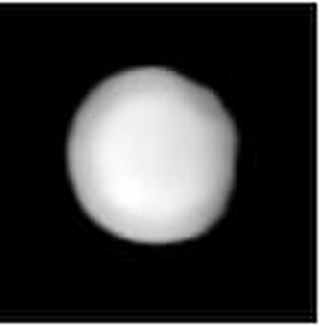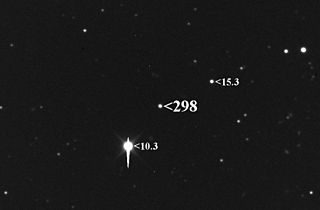A V-type asteroid or Vestoid is an asteroid whose spectral type is that of 4 Vesta. Approximately 6% of main-belt asteroids are vestoids, with Vesta being by far the largest of them. They are relatively bright, and rather similar to the more common S-type asteroid, which are also made up of stony irons and ordinary chondrites, with V-types containing more pyroxene than S-types.

A chondrule is a round grain found in a chondrite. Chondrules form as molten or partially molten droplets in space before being accreted to their parent asteroids. Because chondrites represent one of the oldest solid materials within the Solar System and are believed to be the building blocks of the planetary system, it follows that an understanding of the formation of chondrules is important to understand the initial development of the planetary system.

A chondrite is a stony (non-metallic) meteorite that has not been modified, by either melting or differentiation of the parent body. They are formed when various types of dust and small grains in the early Solar System accreted to form primitive asteroids. Some such bodies that are captured in the planet's gravity well become the most common type of meteorite by arriving on a trajectory toward the planet's surface. Estimates for their contribution to the total meteorite population vary between 85.7% and 86.2%.

Flora is a large, bright main-belt asteroid. It is the innermost large asteroid: no asteroid closer to the Sun has a diameter above 25 kilometres, and not until 20-km 149 Medusa was discovered was an asteroid known to orbit at a closer mean distance. It is the seventh-brightest asteroid with a mean opposition magnitude of +8.7. Flora can reach a magnitude of +8.1 at a favorable opposition near perihelion, such as occurred in November 2020 when it was 0.88 AU from Earth. By September 2023, it will 0.99468 AU from Earth.

Neugrund is a meteorite crater in Estonia. It is 8 km (5.0 mi) in diameter and was previously estimated to have been formed in the Ordovician around 470 Ma, with later research revealing a possible Cambrian origin. The crater is at the bottom of the sea and is not exposed at the surface. Boulders of gneissic breccia found on the coast of Osmussaar, a nearby island, are believed to have been thrown there by the explosion. It has been proposed that the Neugrund crater was created during the Ordovician meteor event when a hypothetical large asteroid transferred directly into a resonant orbit with Jupiter, which shifted its orbit to intercept Earth.
Meteoritics is the science that deals with meteors, meteorites, and meteoroids. It is closely connected to cosmochemistry, mineralogy and geochemistry. A specialist who studies meteoritics is known as a meteoriticist.

The H type ordinary chondrites are the most common type of meteorite, accounting for approximately 40% of all those catalogued, 46% of the ordinary chondrites, and 44% of all chondrites. The ordinary chondrites are thought to have originated from three parent asteroids, whose fragments make up the H chondrite, L chondrite and LL chondrite groups respectively.

The ordinary chondrites are a class of stony chondritic meteorites. They are by far the most numerous group, comprising 87% of all finds. Hence, they have been dubbed "ordinary". The ordinary chondrites are thought to have originated from three parent asteroids, with the fragments making up the H chondrite, L chondrite and LL chondrite groups respectively.

The Flora family is a prominent family of stony asteroids located in the inner region of the asteroid belt. It is one of the largest families with more than 13,000 known members, or approximately 3.5% of all main-belt asteroids.

Space weathering is the type of weathering that occurs to any object exposed to the harsh environment of outer space. Bodies without atmospheres take on many weathering processes:

The LL chondrites are a group of stony meteorites, the least abundant group of the ordinary chondrites, accounting for about 10–11% of observed ordinary-chondrite falls and 8–9% of all meteorite falls. The ordinary chondrites are thought to have originated from three parent asteroids, with the fragments making up the H chondrite, L chondrite and LL chondrite groups respectively. The composition of the Chelyabinsk meteorite is that of a LL chondrite meteorite. The material makeup of Itokawa, the asteroid visited by the Hayabusa spacecraft which landed on it and brought particles back to Earth also proved to be type LL chondrite.

The Baptistina family is an asteroid family of more than 2500 members that was probably produced by the breakup of an asteroid 170 km (110 mi) across 80 million years ago following an impact with a smaller body. The two largest presumed remnants of the parent asteroid are main-belt asteroids 298 Baptistina and 1696 Nurmela. The Baptistina family is part of the larger Flora clan. It was briefly speculated that the Chicxulub impactor was part of the Baptistina family of asteroids, but this was disproven in 2011 using data from the Wide-field Infrared Survey Explorer (WISE).
The Floian is the second stage of the Ordovician Period. It succeeds the Tremadocian with which it forms the Lower Ordovician epoch. It precedes the Dapingian Stage of the Middle Ordovician. The Floian extended from 477.7 to 470 million years ago. The lower boundary is defined as the first appearance of the graptolite species Tetragraptus approximatus.
The Great Ordovician Biodiversification Event (GOBE), was an evolutionary radiation of animal life throughout the Ordovician period, 40 million years after the Cambrian explosion, whereby the distinctive Cambrian fauna fizzled out to be replaced with a Paleozoic fauna rich in suspension feeder and pelagic animals.

The Katian is the second stage of the Upper Ordovician. It is preceded by the Sandbian and succeeded by the Hirnantian Stage. The Katian began 453 million years ago and lasted for about 7.8 million years until the beginning of the Hirnantian 445.2 million years ago. During the Katian the climate cooled which started the Late Ordovician glaciation.
The Sandbian is the first stage of the Upper Ordovician. It follows the Darriwilian and is succeeded by the Katian. Its lower boundary is defined as the first appearance datum of the graptolite species Nemagraptus gracilis around 458.4 million years ago. The Sandbian lasted for about 5.4 million years until the beginning of the Katian around 453 million years ago.
This is a glossary of terms used in meteoritics, the science of meteorites.

The Ordovician meteor event was a dramatic increase in the rate at which L chondrite meteorites fell to Earth during the Middle Ordovician period, about 467.5±0.28 million years ago. This is indicated by abundant fossil L chondrite meteorites in a quarry in Sweden and enhanced concentrations of ordinary chondritic chromite grains in sedimentary rocks from this time. This temporary increase in the impact rate was most likely caused by the destruction of the L chondrite parent body 468 ± 0.3 million years ago having scattered fragments into Earth-crossing orbits, a chronology which is also supported by shock ages in numerous L chondrite meteorites that fall to Earth today. It has been speculated that this influx contributed to, or possibly even instigated, the Great Ordovician Biodiversification Event, although this has been questioned.
In early 2018 there were eight known impact craters in Sweden. They range in age from 90 mya to 470 mya, and in diameter from 1 km to 52 km. Six of them are exposed, that is they are visible at the surface, in the natural landscape, although their nature and origin might need to be pointed out to the untrained layman.
Asteroidal water is water or water precursor deposits such as hydroxide (OH−) that exist in asteroids. The "snow line" of the Solar System lies outside of the main asteroid belt, and the majority of water is expected in minor planets. Nevertheless, a significant amount of water is also found inside the snow line, including in near-earth objects (NEOs).












